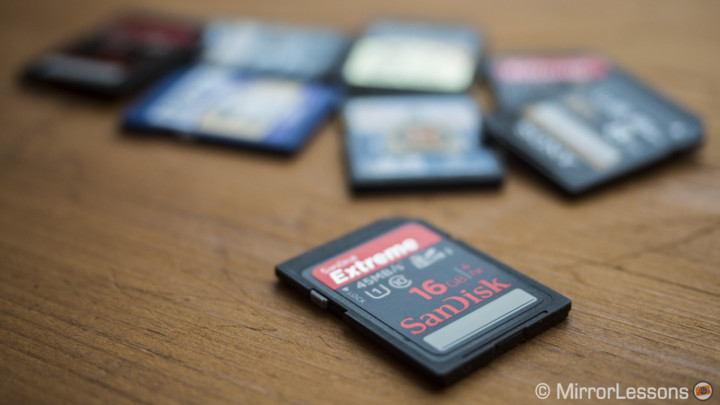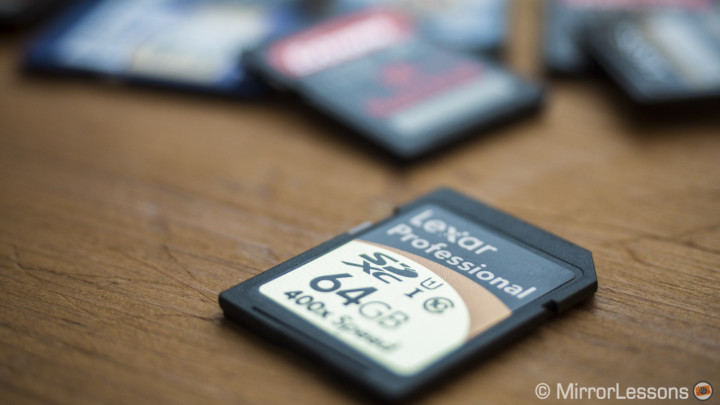What Size Card Does The Nerf Hd Camera Use
One memory card is every bit practiced as another, you say? Though on the outside they may await nigh identical, the performance and capacity of your memory bill of fare can vary, but equally a $2000 MacBook tin run circles around a $200 notebook computer. Memory cards are congenital with different capacities for the aforementioned reason cameras are built for unlike purposes–for the uncomplicated reason that photographers have varying needs. A sports or wildlife photographer, for case, will certainly need a memory card that is both fast and capacious for rapid shooting sequences, whereas a mural or street photographer may care less about these aspects. And let'due south not forget that in recent years at that place is likewise video recording involved.
Earlier yous purchase a memory card for your mirrorless camera, information technology is important that you carefully consider the following four points–compatibility, brand, speed and space. Doing so will most probable save you money, as y'all will choose a retention carte that actually suits your needs, and will help y'all go the well-nigh out of your shooting feel.
Ethics statement: Within the article, there are affiliate links. If you decided to buy something after clicking the link, nosotros will receive a minor commission. Don't worry – prices remain the aforementioned for you. To know more well-nigh our ideals, you tin visit our full disclosure page. Thanks!
Are the retention menu and photographic camera uniform?
This is the outset signal you must consider when ownership a retentivity card. In total, there are four categories into which memory cards are divided:
- SD (128MB to 2GB). The first generation SD card. They have been discontinued merely if you find some around your firm, they will work on all SD, SDHC, or SDXC devices. Note that they might not exist compatible with the video recording capabilities of today'due south cameras.
- SDHC (4GB to 32GB). Nearly cameras built after 2007 should be compatible with SDHC. Information technology is not backwards compatible with cameras that only have SD.
- SDXC (64GB to 2TB). Most cameras congenital afterwards 2010 should be uniform with SDXC. It is non backwards compatible with cameras that only take SD or SDHC.
- UHS-I and UHS-2 (Ultra High Speed). Enhancements of original SDHC or SDXC interface with improved write and transfer speeds. There are no backwards compatibility issues.
All mirrorless cameras will accept either standard SDHC or SDXC memory cards. The divergence between these two standards is that SDXC has a higher storage capacity and about of the cards accept a faster writing speed. Either card type may have an Ultra Loftier Speed charabanc that basically enhances the writing/transfer performance of your SDHC/SDXC card. While a UHS-I card volition piece of work on not-UHS-I cameras, you volition just observe the benefits if your camera is uniform with the Ultra High Speed bus. Almost all recent cameras are UHS-I uniform just at the time of writing, the only camera that is compatible with the brand new UHS-II format is the Fujifilm X-T1, but this will surely alter in the near future.
If in doubt, detect out which retention cards are compatible with your mirrorless camera by just referring to the manual or looking upward the camera specifications online.
Is it a well-known brand?
We've heard one as well many a horror story nigh photographers shooting unabridged sessions with an SD memory bill of fare made by an unknown 3rd-party, just to observe subsequently on that some information went missing, or that the images weren't there at all! Of grade bad luck tin can strike even with brand proper noun bill of fare, but it is far less likely. To avoid the embarrassment of telling your customer that your images have mysteriously disappeared, play it condom and always go with a respected brand proper name–the difference in cost between one make and another is minimal anyhow if y'all consider the long term benefits.
Our favourite brands:
- Lexar
- SanDisk
- Transcend
Transcend cards are cheaper than Sandisk and Lexar but so far we've never had a single result with any of these cards and Mathieu has used them a lot for video recording. For our mirrorless cameras we take lots of 16GB Sandisk Extreme Form 10 45mb/s, and these are the cards we use for all the photos y'all see on our website. They are fast enough even for continuous shooting and are non expensive.

Is it spacious?
Just ten years agone, people would have found it difficult to believe that one would demand any more 2GB of space on a retention card. Fast frontward to 2014, and we now accept memory cards that can contain up to 2TB of information. That said, the average photographer volition rarely need anything more than 32GB of space, and oft, even cards with just 8 or 16GB will suffice. The amount of space you want from your card will depend very much on how much you shoot, how you shoot, and whether you programme to behave extra retentiveness cards with yous.
In our case, for example, nosotros tend to focus on street, landscape and macro photography where burst shooting is rare. Not only, merely we ever carry around a retentiveness card case with 4-v extra cards should the i we are using make full up or malfunction. This ways that 16GB is more than enough for our needs. If yous are a sports or wildlife shooter, on the other hand, you may detect your menu filling upwardly quite rapidly, peculiarly if yous shoot in raw-JPG format in burst mode. In this case, you'd certainly feel more comfortable with a memory card that has at to the lowest degree 64GB of space. Moreover, some RAW files accept up more space than others. For instance Fuji RAW files are among the biggest (more than 30MB).
When working, Mathieu tends to use more cards with less space instead of 1 or two cards with abundant space. The reasoning is that if he loses one menu, he will lose fewer photos than if the card were smaller. Of course this is but one mode of working–other people might prefer to behave around fewer cards. In the end you accept to work with what makes you comfortable.

Is it fast?
Standard SDHC/SDXC memory cards tin can be divided into iv different Speed Class standards: two, 4, half-dozen and 10. These numbers correspond to the minimum rate at which the writing of information can be sustained, with 2 (2MB/sec) being the slowest and 10 (10MB/sec) beingness the fastest. However, it is completely possible for a well-made memory card to outperform its category–for instance, a Class 2 retention card could potentially achieve a write speed of 4 or 8MB per second. Even though this is possible, you should always buy a memory card that meets or outdoes the requirements of your host device (camera), meaning that if your photographic camera requires Speed Class 4 SD retentivity card, you should use a card with a Speed Course standard of 4, half-dozen or 10.
USH-I and Two memory cards, on the other hand, have a Speed Class of either 1 or three. Form 1 denotes a minimum write speed of 10MB per second whereas Grade 3 starts from an amazing 30MB per second. Form 3 is also capable of recording 4K video. These values are only valid on cameras that are USH-I or USH-II compatible.
Build quality
Cheaper SD cards from less well-known brands can be less robust than others just I've always found that SD cards in full general are not the best when information technology comes to robustness. For example more than once the write-protect switch has broken on our cards, leaving them write-protected without the possibility to enable them once more. A good tip could be to put information technology in your card holder the other way effectually so that you lot know that the data contained in the cards needs to be backed up before using it again, instead of protecting the carte du jour by using the switch. The full general rule is to handle them with care especially when inserting them into the card slot on your camera, and ever keep them condom in an SD card holder. We personally haven't had any existent problems so far merely they are certainly less solid than compact flash cards or larger memory supports.
Our recommendations:
Here are three of the most spacious and affordable retentivity cards on Amazon. You can observe retentiveness cards with even more than space than this simply they are on the pricey side and aren't necessary for the boilerplate photographer.
- Lexar Professional 600x 128GB SDXC UHS-I Flash Retentiveness Carte du jour
- Transcend 128GB High Speed Class ten UHS Wink Memory Card
- SanDisk Ultra 128 GB Secure Digital Extended Capacity (SDXC)
If you don't need lots of space or a very fast writing speed, hither are three SD cards that are inexpensive and reliable. These volition suit yous fine even for Full Hard disk drive shooting with AVCHD codes that are around 28 mb/s of data.
- SanDisk Farthermost Plus 16GB SDHC UHS-ane Flash Memory Card Speed Up To 80MB/southward
- Transcend xvi GB Loftier Speed 10 UHS Flash Retentivity Card (up to 45 MB/s, 300x)
- Lexar Professional 400x 16GB SDHC UHS-I Flash Retentivity Menu
Here are three memory cards which identify priority on speed. They are all SDXC format with Speed Class 10 and UHS-I. They will too adapt Hard disk or 4k video with a high data charge per unit (100mb/south or more) very well.
- Transcend 128GB High Speed Class 10 UHS Flash Retentiveness Carte du jour
- SanDisk Extreme Pro 64GB SDXC UHS-1 Flash Memory Card
- Lexar Professional person 600x 128GB SDXC UHS-I Flash Memory Card
Source: https://www.mirrorlessons.com/2014/08/12/buy-sd-memory-card-mirrorless-camera/
Posted by: ryanyesposiond.blogspot.com

0 Response to "What Size Card Does The Nerf Hd Camera Use"
Post a Comment